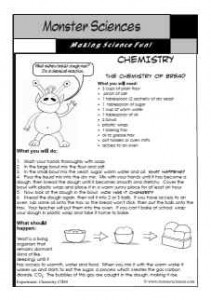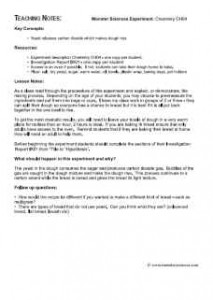What is it that makes bread rise? There’s one way to find out – let’s make some!
 |
 |
What you will need:
• 3 cups of plain flour
• pinch of salt
• 1 tablespoon (2 sachets) of dry yeast
• 1 tablespoon of sugar
• 1 cup of warm water
• 1 tablespoon of oil
• 2 bowls
• plastic wrap
• 1 baking tray
• oil to grease tray
• pot holders or oven mitts
• access to an oven
What you will do:
1. Wash your hands thoroughly with soap.
2. In the large bowl mix the flour and salt.
3. In the small bowl mix the yeast, sugar, warm water and oil. What happens?
4. Pour the liquid mix into the dry mix. Mix with your hands until it has become a dough, then knead the dough until it becomes smooth and stretchy. Cover the bowl with plastic wrap and place it in a warm sunny place for at least an hour.
5. Now look at the dough in the bowl. How has it changed?
6. Knead the dough again, then roll it into 2 or 3 balls. If you have access to an oven, rub some oil onto the tray so the bread won’t stick, then put the balls onto the tray. Your teacher will put them into the oven. If you can’t bake at school, wrap your dough in plastic wrap and take it home to bake.
What should happen:
Yeast is a living organism that remains dormant (kind of like sleeping) until it has access to warmth, water and food. When you mix it with the warm water it wakes up and starts to eat the sugar, a process which creates the gas carbon dioxide, CO2. The bubbles of this gas are caught in the dough, making it rise.
Teaching Notes: Monster Sciences Experiment: Chemistry CH04
Key Concepts:
• Yeast releases carbon dioxide which makes dough rise Resources:
• Experiment description Chemistry CH04 – one copy per student.
• Investigation Report IR01 – one copy per student
• Access to an oven if possible. If not, students can take their dough home to bake.
• Flour, salt, dry yeast, sugar, warm water, oil, bowls, plastic wrap, baking trays, pot holders
Lesson Notes:
As a class read through the proceedure of this experiment and explain, or demonstrate, the mixing process. Depending on the age of your students, you may choose to pre-measure the ingredients and put them into bags or cups. I have my class work in groups of 2 or three – they can split their dough so everyone has a chance to knead but it is best if it is all put back together in the one bowl to rise.
To get the most dramatic results, you will need to leave your bowls of dough in a very warm place for no less than an hour, 2 hours is ideal. If you are baking the bread ensure that only adults have access to the oven. Remind students that if they are baking their bread at home they will need an adult to help them.
Before beginning the experiment students should complete the sections of their Investigation Report IR01 from ”Title to “Hypothesis”. What should happen in this experiment and why? The yeast in the dough consumes the sugar and produces carbon dioxide gas. Bubbles of the gas are caught in the dough mixture and make the dough rise. This process continues to a certain extent while the bread is baked and gives the bread its light texture.
Follow up questions:
• How would the recipe be different if you wanted to make a different kind of bread – such as multigrain?
• There are types of bread that do not use yeast. Can you think what they are? [unlevened bread, flat bread, lavash etc)



